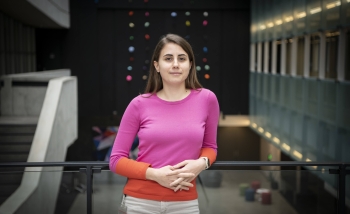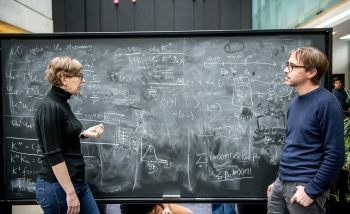Is this the new face of Feynman diagrams? “Well,” Perimeter Faculty member Freddy Cachazo modestly replies, “That’s a provocative question. Ask people again in 65 years.”
It was 65 years ago that Richard Feynman introduced his diagrams to the world, simplifying the way physicists model particle interactions. Generations of researchers since have used Feynman diagrams to help them calculate what happens when two or more particles collide, a process generally known as scattering. Visual and simple, Feynman diagrams have become the standard way to get an intuitive handle on what would otherwise be a rather abstruse calculation.
“Feynman diagrams were and are a dream come true,” says Cachazo. “They work very well; they have allowed us to test the predictions of quantum field theory to incredible accuracy. Also, they make locality, one of the two pillars of quantum field theory, manifest along the computation. But all this comes at a cost: Feynman diagrams contain a large amount of redundancy.”
Diagram by diagram, Feynman diagrams can produce as final states particles that are physically impossible. You have to add up all the possible diagrams to show that the probability for those physically impossible states is actually zero.
The trouble is “all possible diagrams” can be many, many diagrams. Calculating what happens when massless particles such as gluons collide, for example, requires hundreds of Feynman diagrams even in simple events where just two gluons interact to produce a few more.
Each of these hundreds of diagrams produces many terms in the formula; this makes it infeasible to do these calculations by hand. These problems can now only be handled using powerful computers – and for complex collisions, like the ones happening at the LHC supercollider, they are beyond the reach of the best supercomputers.
A more efficient process for calculating scattering amplitudes is, therefore, at the top of every particle physicists’ wish list. At CERN and elsewhere, researchers smash together subatomic particles at high energies, looking for new particles and forces not accounted for in the Standard Model of physics.
In order to discover new phenomena, though, it is necessary to first precisely calculate what current theoretical models predict about particle interactions at very high energies – you can’t spot the unusual unless you know exactly what the usual looks like. Calculating scattering amplitudes is central to that prediction – and the redundancy in the Feynman diagram approach to scattering amplitudes has, until now, been a major stumbling block.
Where does the redundancy in Feynman diagrams come from? In a nutshell: virtual particles. Anyone looking at a Feynman diagram might get the impression that the diagram is telling a story of particles interacting. But the internal lines in Feynman diagrams – the ones tracing “particles” that are neither input nor output – do not actually represent physical particles. Instead, they are said to represent virtual particles – particles whose momenta are physically impossible.
“It is natural to ask if virtual particles are strictly necessary,” says Cachazo. “Is it possible to describe the interaction of physical particles using only physical particles? The new answer is: yes.”
Cachazo is part of a small group of mathematical physicists who have developed a new scheme to do just that. The others are Nima Arkani-Hamed of the Institute for Advanced Study (who is also a Perimeter Distinguished Visiting Research Chair), Jacob Bourjaily of Harvard, Alexander Goncharov of Yale, Alexander Postnikov of MIT, and Jaroslav Trnka of Princeton.
In a massive 152-page paper, the team walks the physics community through the elegant mathematical ideas behind a new system for calculating what happens when particles interact. In this new picture, virtual particles make no appearance at all.
With virtual particles eliminated, calculating scattering amplitudes becomes astonishingly simple. The paper is the culmination of over a decade of work, and it’s likely to have wide implications for physics and mathematics. To begin with, this system may well revolutionize the way particle physicists do their most essential calculations.
Why does using complex numbers make calculations so simple? In physics, it is often the case that when the results of calculations are much simpler than expected, then there is some principle or symmetry that has been missed. It is not yet clear whether that’s true in this case, or what the missed symmetry might be – but there are hints about fundamental, as-yet-undiscovered physics related to theories of space and time. If we are lucky, this new mathematical lens on scattering theory may bring new ideas to light.
The new system has already attracted widespread excitement in the particle physics community. It is expected that this major paper will be a focal point for years to come.
FURTHER EXPLORATION
About PI
Perimeter Institute is the world’s largest research hub devoted to theoretical physics. The independent Institute was founded in 1999 to foster breakthroughs in the fundamental understanding of our universe, from the smallest particles to the entire cosmos. Research at Perimeter is motivated by the understanding that fundamental science advances human knowledge and catalyzes innovation, and that today’s theoretical physics is tomorrow’s technology. Located in the Region of Waterloo, the not-for-profit Institute is a unique public-private endeavour, including the Governments of Ontario and Canada, that enables cutting-edge research, trains the next generation of scientific pioneers, and shares the power of physics through award-winning educational outreach and public engagement.
You might be interested in


